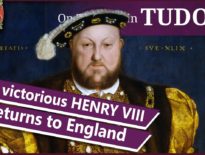On this day in Tudor history, 29th September 1528, the papal legate, Cardinal Lorenzo Campeggio, landed at Dover on the Kent coast.
Campeggio and Cardinal Thomas Wolsey, who had been appointed the pope's vice-regent, were given the task of hearing Henry VIII's case for an annulment of his marriage to Catherine of Aragon.
Find out more about what happened when next, what happened at the special legatine court, and how Henry ended up waiting for his annulment for a few more years, in today's talk.
Find out more about Catherine of Aragon's speech at the court in this video:
Also on this day in Tudor history, 29th September 1564, Michaelmas, the queen’s favourite, Robert Dudley, was made Earl of Leicester and Baron Denbigh in front of the Scottish ambassador, Sir James Melville. Elizabeth I made Dudley an earl so that he'd be suitable as a potential bridegroom for Mary, Queen of Scots, but she couldn't refrain from a display of affection during the ceremony, tickling him on the neck! Why was Elizabeth prepared to marry her favourite off to Mary? Find out in last year’s video:
Also on this day in history:
- 1553 – Mary I created fifteen Knights of the Bath as part of her coronation celebrations.
- 1558 – Death of George Brooke, 9th Baron Cobham, soldier and landowner. He was buried at Cobham Church. Cobham acted as Lieutenant-General in spring 1544 when English forces invaded Scotland, and was made Deputy of Calais in June 1544. He was created a Knight of the Garter in 1549, and was on Edward VI's Privy Council. He was imprisoned in the Tower of London temporarily in 1554 after being implicated in Wyatt's Rebellion, but was released and fined.
Transcript:
On this day in Tudor history, 29th September 1528, the papal legate, Cardinal Lorenzo Campeggio, landed at Dover on the Kent coast. In early 1528 Cardinal Thomas Wolsey, Henry VIII’s right hand man, had written to Pope Clement VII outlining Henry VIII’s demand that the case for an annulment of his marriage to Catherine of Aragon be decided in England by Wolsey and a visiting papal legate, who would act with the full authority of the Pope. On the 13th April 1528, a papal bull had empowered Cardinal Wolsey as the Pope’s viceregent “to take cognisance of all matters concerning the King’s divorce” and Campeggio had been made papal legate in June 1528 in preparation for hearing the divorce case.
On the 8th December 1528, Cardinal Campeggio arrived in London but historian Eric Ives explains how his “powers were not complete” which necessitated “further wearisome and unsatisfactory negotiation” with the papacy. This lack of authority was actually a papal stalling tactic.
Things were made worse for Henry VIII and Wolsey when Catherine of Aragon produced Pope Julius II’s dispensation for her to marry Henry. This put a spanner in the works and caused delays with the case. In the meantime, Campeggio met with Catherine and advised her to join a convent, something which would allow the marriage to be annulled easily. However, Catherine believed that she was Henry’s true wife and queen and would not agree to taking the veil.
Henry VIII and Wolsey then played dirty, threatening Catherine with separation from her daughter, Mary, if she would not obey the King. Instead of submitting to the King, Catherine decided to fight back.
Campeggio could only stall for so long and formal proceedings finally began on the 31st May 1529 at the Legatine Court at Blackfriars.
On 16th June 1529, at Baynard’s Castle, Catherine met with William Warham, Archbishop of Canterbury; Cuthbert Tunstall, Bishop of Durham; Nicholas West, Bishop of Ely; John Clerk, Bishop of Bath and Wells; John Fisher, Bishop of Rochester; Henry Standish, Bishop of St Asaph; Jorge de Athequa, Bishop of Llandaff; her almoner, Robert Shorton, and John Talcarne. In their presence, she wrote a formal appeal to the Pope against the authority of the legatine court, requesting that the case be heard in Rome.
Two days later, Catherine and her husband, Henry VIII, were summoned to appear before the court. The king sent proxies, Richard Sampson, dean of the Chapel Royal, and Dr John Bell, but Catherine chose to appear at the court in person, accompanied by her ladies-in-waiting and the bishops who were to act as her counsel for the proceedings. Henry Ansanger Kelly explains that Catherine “read a protest, the essence of which was that her appearance there and anything that she should say were not to be taken as an indication of approval of the legates as competent judges in the case, nor to derogate from any allegations, protestations, provocations, appeals, complaints, supplications, recusations, and reclamations made to the pope”. She made the point that the judges were far from impartial, being closely associated to the king, and stated that the court proceedings should not be taking place while the case was still pending at Rome. She instructed that her protest be recorded and the judges stated that her protestation would be answered in proceedings on 21st June.
On 21st June, Catherine AND Henry appeared at the court. Rather than simply confirming her attendance, Catherine sank to her knees in front of her husband and gave the speech of her life. I’ll give you a link to my talk on her speech, in which I read it in full. It’s an incredible speech. She reminded the king that she’d been his true wife for 20 years and that she’d been a true maid at their marriage. She concluded it by committing her cause to God. Catherine then rose to her feet, curtseyed to the King and walked out of the court, ignoring those who tried to make her return to her seat and saying, “On, on, it makes no matter, for it is no impartial court for me, therefore I will not tarry. Go on.”
Catherine had stolen the show and her speech was hard to follow. Henry VIII addressed the court speaking of his love for Catherine but also of his troubled conscience regarding the fact that he had acted contrary to God’s law in marrying his brother’s widow.
Over the next month, Henry VIII tried to prove that Catherine had consummated her marriage to his brother, Arthur, but Catherine had already signed protestations of her virginity and Bishop John Fisher shocked the court in his defence of Catherine’s virtue, quoting from the Book of Matthew and saying:
“Quos Deus conjunxit, homo non separet. ‘What therefore God has joined together, let not man put asunder.’ And, for as much as this marriage was made and joined by God to a good intent, I say that I know the truth; which is that it cannot be broken or loosed by the power of man.”
He then said that he was so convinced of Catherine’s cause that he would lay down his life for it.
Henry VIII then sent Wolsey and Campeggio to see Catherine, to try and bully her into submission, but this failed miserably. In desperation, Campeggio tried another stalling tactic. In July 1529 he announced that the court would adjourn until October, for a summer recess due to the fact that it was “reaping and harvesting” time in Rome, a time when courts did not sit. Henry VIII was furious but the Legatine Court was suspended, never to sit again because then news reached England that Catherine’s appeal to Rome had been successful. It was a huge blow for Henry, who had expected the court to pass sentence and rule in his favour.
Henry VIII’s marriage to Catherine of Aragon was not annulled until nearly 4 years later, in May 1533 when Archbishop Thomas Cranmer and his court ruled that Henry and Catherine had never been legally married and that the King’s marriage to Anne Boleyn, which had taken place in secret on the 25th January 1533, was valid. A pregnant Anne Boleyn was crowned Queen of England just days later.



Leave a Reply